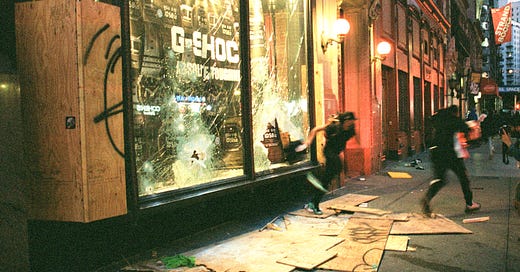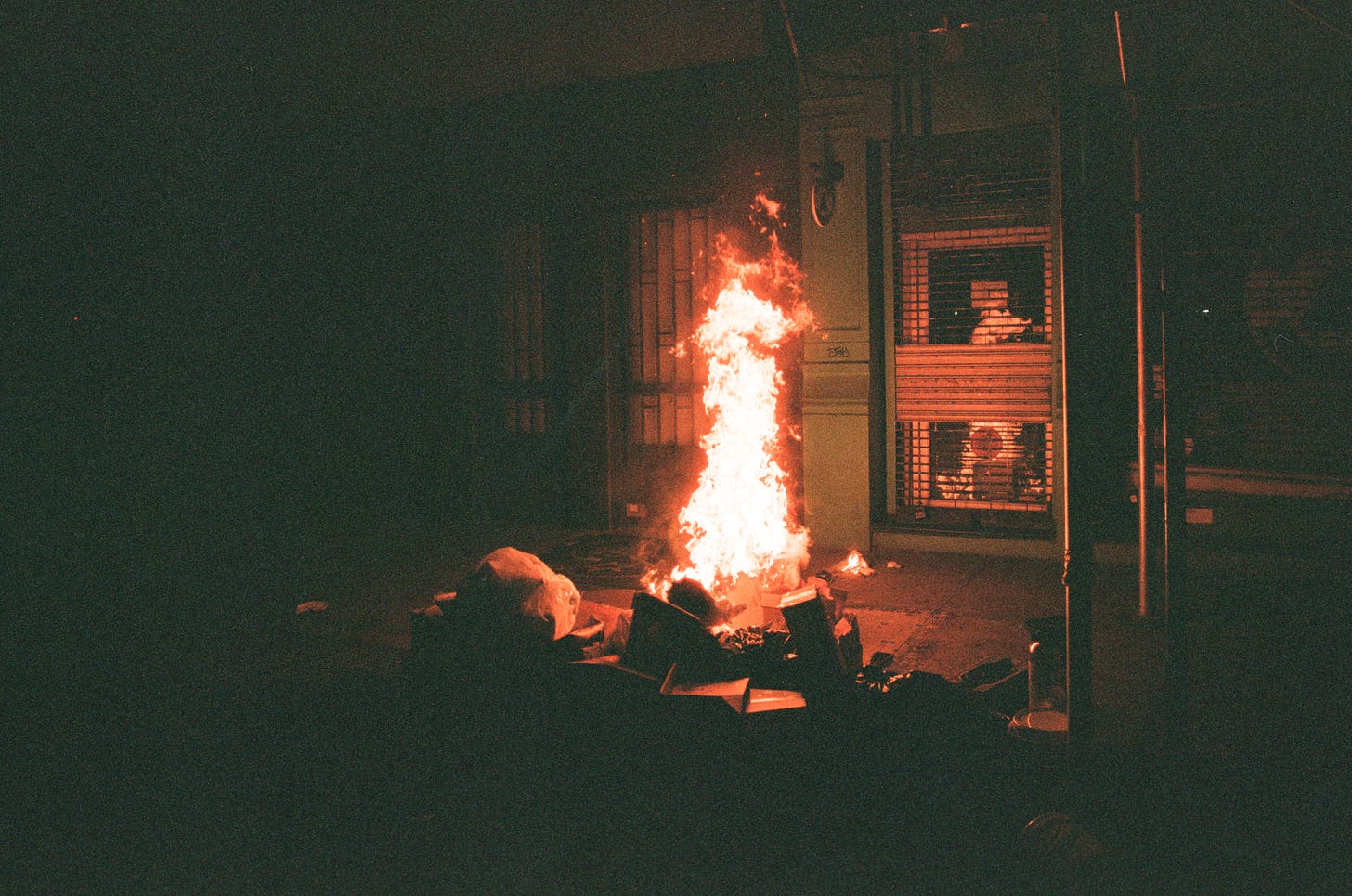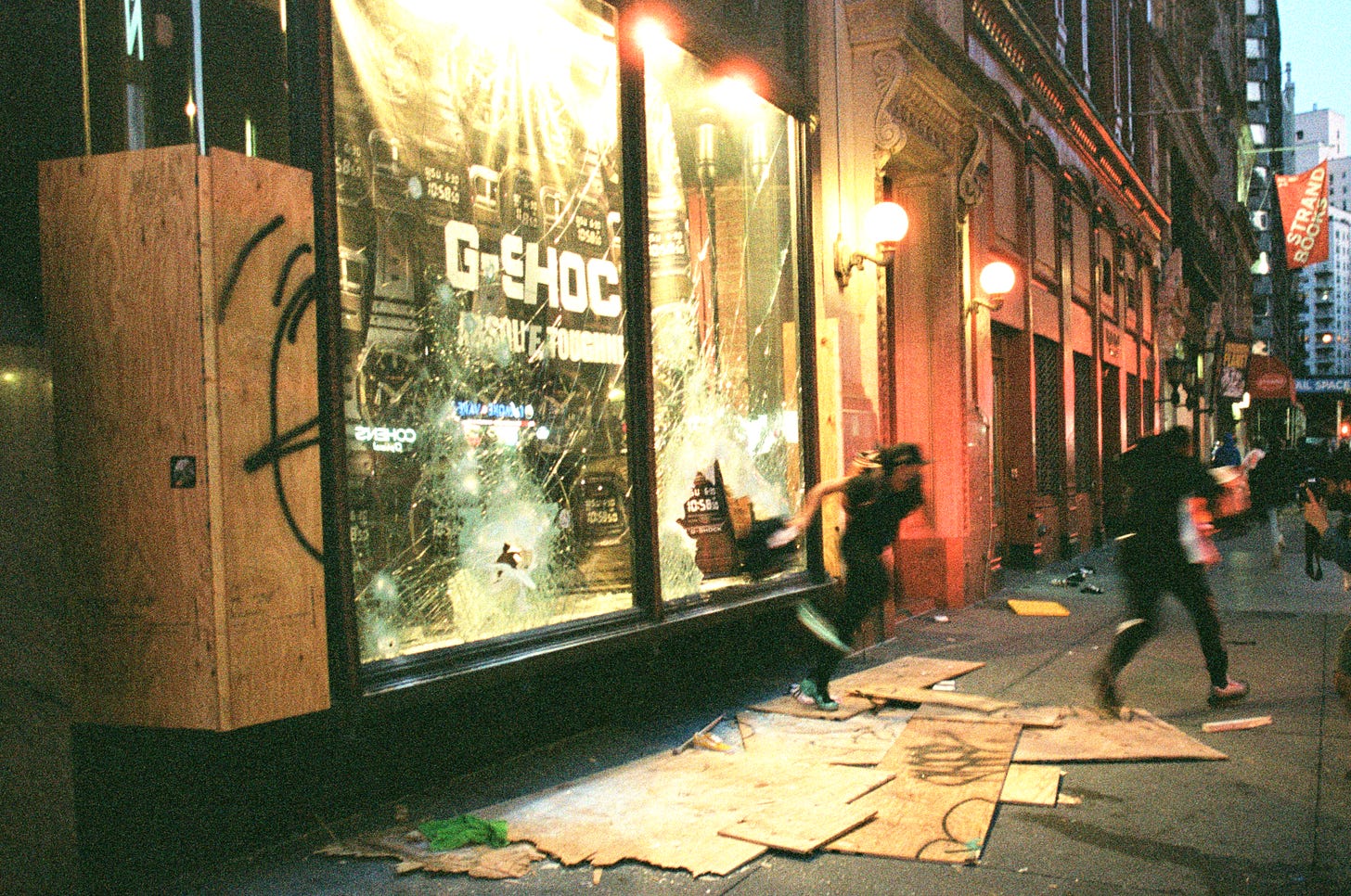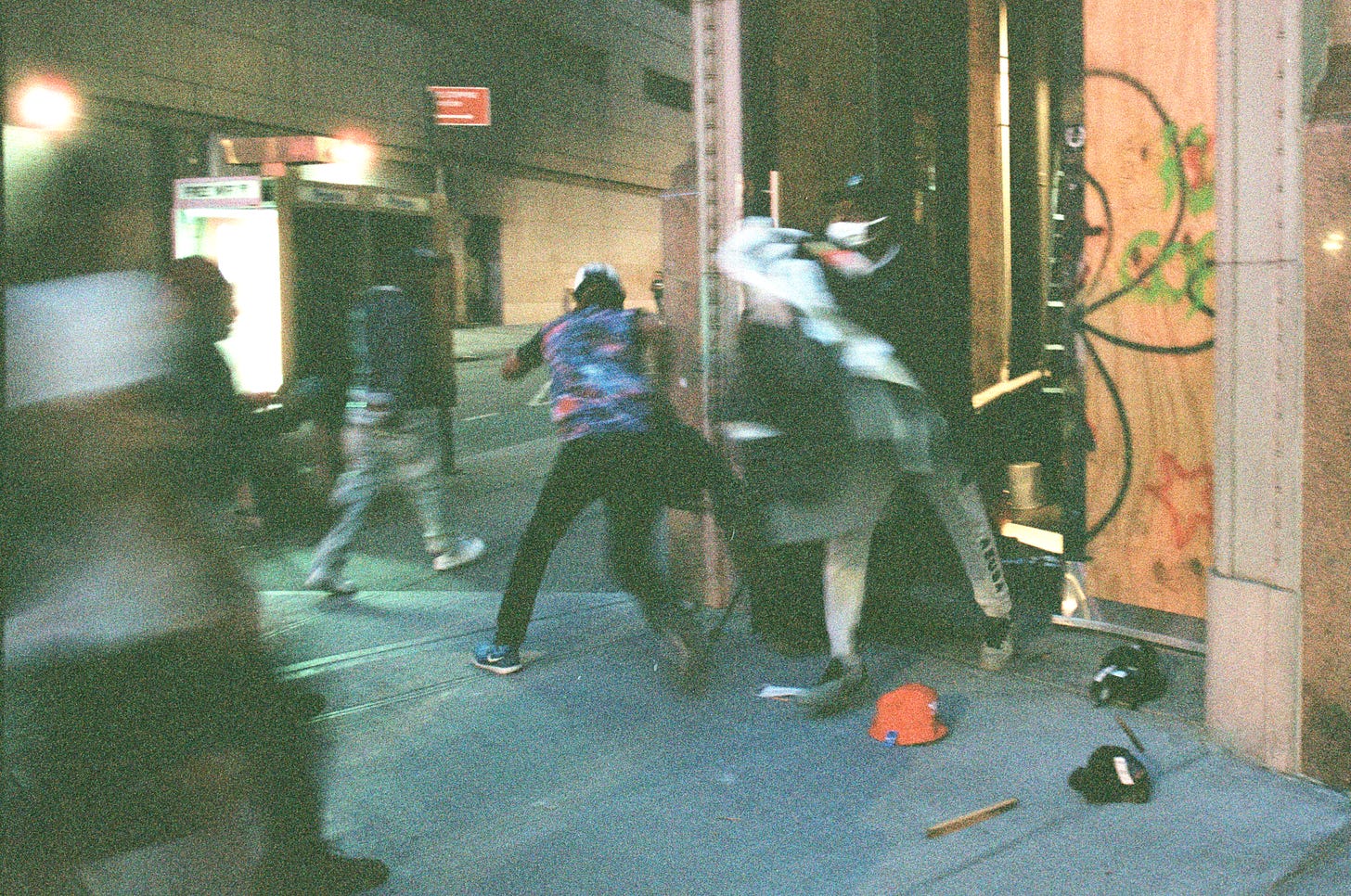The Sunday Night Riots, Mass Looting in SoHo After Day of Peaceful Protest
The first night of rioting in Manhattan marked a moment in New York City unlike any other since the 1977 blackout
It was a beautiful last day of May when protesters gathered on both sides of the East River. Despite the tragedy of George Floyd's murder, there was a rare optimism in the air as citizens of all races united on the streets to demand social change. With the picture perfect sunset radiating on the horizon, marchers made their way from Brooklyn across both vehicle lanes of the Manhattan Bridge as nearly every car's horn honked with delight in the day's final moments. But the troubles began after dusk, as is usually the case.
By 10 PM the peaceful march reached Bryant Park where its five and half mile journey was brought to a halt by a police riot line. Then protesters dispersed in all directions as police batons cut through the Sunday night and struck their bodies. The protest was over. In its place was the drumbeat to war. It started slowly at first, as disparate groups of youths made their way south. Trash can fires began appearing, then more frequently with each block. When bank windows started to turn up smashed it was clear the city was on the verge of something – but what? No one could have known.
Just as the clock struck midnight, the riot metastasized almost at once. For the next three hours SoHo was the epicenter of a full-blown riot, likely Manhattan's first in 50 years. The blocks between Houston and Canal Streets, and Broadway and West Broadway, were a complete free-for-all, with no organized police presence in the roughly twenty-block zone of luxury and high-end retail stores. There was looting, fire, brawling, someone was even shot. The crowd ruled absolutely. And any stray cop who found themselves here retreated in the closest direction to Houston, Broadway or Canal, where the police did have a fortified yet completely ineffectual presence. Most of the looting victims were high-end corporate brands, but make no mistake that locally-owned small businesses were spared.
Who were the rioters? In short, the rioters were not protesters. They were not "antifa". They were not the protesters earlier in the day who chanted and marched. There was no chanting during the riot. There was only the cacophony of hundreds of criminals looting every store in every direction systematically for blocks, operating in tight crews. It was a vast celebration of a windfall of profit. There were the loud booms of rioters breaking through the glass of one store after the other, the crashing of plywood ripped down proficiently from boarded storefronts, the grating of metal as roll down riot gates were pried off their tracks, the twinkling sound of glass crashing to the ground and crumbling beneath the feet of looters, the chorus of burglary alarms harmonizing with each other across streets, the roaring of motors as getaway cars and scooters drove wildly through SoHo, the stomping of thousands of feet against the quaint cobblestone streets, the distant sound of fire and police sirens many blocks away.
As the looters emptied the inventories of stores into their pockets, garbage bags, and just their hands, there was usually a getaway car not far away to relieve them of their loot before they would go right back and grab more merchandise from another store. This process repeated continuously. The looters for the most part all wore masks in the coronavirus fashion, but some wore ski masks. The majority were men but there were also crews of women, albeit the women exhibiting a different looting style, at times clashing verbally with the men but never resorting to blows. Citibikes were everywhere – presumably ripped by force from their kiosks as was done throughout the night – many of their riders with piles of loot sitting awkwardly in their laps. Scooters from Revel, the for-hire rental scooter app, were also everywhere, often with one person driving with a second person hitched on the back with a trash bag of loot.
The rioters had blockaded the streets leading to and in between the blocks of SoHo with any obstacle that could be dragged into the street – traffic cylinders, garbage cans, wooden pallets, police and ConEd barricades – presumably to stave off law enforcement. And it worked. At times a rioter would pull a blockade aside for their getaway driver to enter the vicinity of a looted store, and then they would close the street again. Other drivers just wildly ran over the debris or around it on the sidewalk. Many cars throughout the night had flat tires, but seemingly continued unphased. By my estimation, the looters were mostly organized and experienced criminals. For sure, some of the small crews of youths who committed random small-scale vandalism earlier in the night after the protest were in it too, but they seemed to be bit players in the riot, which was ruled mostly by who are likely career criminals. I have strong doubts that any of the crews with getaway drivers were present at the protests at all, most likely driving downtown explicitly to loot. The dynamic of the riot was highly organized, albeit appearing that it was the sum of scores of smaller teams of criminals, acting in concert yet competing with one another.
Through the looting there was the telltale calling of "YO!" that pierced through the raucous every few moments. This was understood by all to be a signal that a new store had been breached. With every "YO!" looters would stop what they were doing and begin running in mass in whatever direction it was, down the block and around corners, and then that store would be picked to the bone. As looters ran in every direction they would go about dropping loot – sneakers, winter coats, pants, and jackets – sometimes they would stop to pick it up, other times they would leave it to be trampled or picked up by others. There were empty boxes, tissue paper, and plastic packaging strewn about everywhere, ankle deep in places, as most looters would unbox the stolen goods thoroughly before unloading them into their getaway vehicles or into their garbage bags.
One of the most popular stores of the night was Gucci, which attracted the largest continuous mob that I witnessed that night. The Gucci store was looted continuously for over an hour. At times there was a rumor that "the cops are coming!" and there would be a brief stampede, but then moments later the looters would return, evidently because there never were any cops coming. The demand for Gucci was so high, that at times brawls broke out outside the store, as looters robbed one another for their stolen wares. Someone would come out of the store with more than they could defend and someone else would assault them and run off with the goods. At one point somebody tried to rob the wrong looter and he pulled out a baton-style stun gun. The armed looter took a defensive stance and rotated his hips slowly 180 degrees daring the crowd to attack. He was was not robbed.
Besides Gucci, looters also hit: Rolex, Chanel, Coach, Diesel, Burberry, Ugg, Patagonia, Dr. Martens, Moose Knuckles – too many to list exhaustively at this times. According to crime data released by the NYPD, for the first and fifth precincts, which encompass SoHo, 60 burglaries were counted for the two calendar days Sunday and Monday – the night and morning of the riot. That is up from four burglaries for the same period the previous week, and one for the week before that. Though SoHo was hit the hardest, burglaries for these two days was multiplied in every precinct south of Central Park – Manhattan South recording 173, up from 11 the previous week, and 14 the week before that.
By 2 AM looting continued throughout the blocks of SoHo but it was clear that the pickings were getting slim. A crowd reached Canal Street, and overhearing their ramblings, it was clear they were seeking and itching for the next target. There it was at Canal and Church Streets, a corner smoke shop. As a group began making clockwork of the riot gate, a crew of women looters voiced their disgust, "that ain't even a corporate store, that's a small business," and less than a minute later the store was breached and ransacked. Within a moment, looters were running in every direction with hookahs and bongs in both hands, handfuls of pipes and vaporizers.
Too late to save the store, a squad of police cars sped by in formation and looped around, scaring off looters, but the cops did not stop and no arrests were made. This was a common and completely useless tactic employed throughout the night by NYPD against the rioters outside the main riot zone in SoHo. There would be looters in a store, cop cars would drive by and blare their sirens, loop around, the looters would run, then the cops would speed off somewhere else. And then the looters would return to the very store sometimes ten seconds later. But at no point did I see any police on foot engage any looter and at no point did I see any rioter arrested.
A block south of the smoke shop, I came across a black man's body laying face down in the middle of the street, at Lispenard and Church Streets. His body was contorted in such unnatural ways that I assumed he was dead. The police blockaded the street and tried to hide the sight of him with their vans. I speculated that he was hit by a car. After the body was taken away in an ambulance, I asked a group of young high-school-aged girls sitting in a doorway what happened. Nonchalantly, one of them speculated the police had beaten the man. The girls were flanked by hookahs sitting on either side of them.
According to police records, someone was shot during the riots on Spring Street at Crosby Street. The New York Post reported that a 21-year-old looter was shot here in the back by a rival crew member for turf over looted stores. So far, there are no police records about the man I saw on Lispenard, and I have not read any news accounts of him.
Back on Canal, two men from the smoke shop surveyed the remains of their devastated store, looks of helpless resignation on their faces, as they struggled to understand why their small business had been destroyed.
Looting continued rampantly in SoHo, then on Broadway at Howard Street a scene of utter chaos unfolded. The Foot Locker was breached and looters swarmed. Someone lit a dumpster on fire and flames raged as the looters ran to and fro with sneakers in their arms. A police vehicle tried to chase a getaway car, then it bolted onto the sidewalk and accelerated madly with bystanders and looters jumping out of its way, myself included, the car narrowly missing my body before it broke free onto Broadway and sped off into the night uncaptured. The dumpster fire was out of control as construction debris inside was popping off spitting flames and smoke into the sky.
On Broadway I spoke with a black woman who was paid to guard the Chase Bank at Canal Street. She was shocked at what she saw, in disbelief as we all were that this could happen to lower Manhattan. We talked about George Floyd, that his murder and that of so many others was reprehensible. But we agreed that the riot had nothing to do with the protests. We both speculated that there would be a curfew the next day – which there was – and that the National Guard would be sent – which it was not. She was disturbed and we parted ways each wishing the other "be safe."
By 3 AM much of the rampant looting had died down and what was left were dispersed groups of looters, arms full of loot, wandering about unafraid as cop cars whirred occasionally in any direction, but not stopping. There were countless storefronts breached at this time and the remaining looters would casually rummage them as they encountered one, no longer running unless they saw a police officer. In wake of the mobs were bands of demoralized and humiliated police officers. As one resident stood outside the entrance to his apartment building, a sergeant walking by paused briefly, looked at the man, wordlessly shrugged his shoulders and resumed trudging again up the street. Minutes earlier, looters had breached a clothing store, but fled without taking much.
Walking up Broadway in the early twilight of the morning was a scene scarcely imagined. There were still small fires everywhere and trash splayed in every direction, broken glass, spray paint on nearly every surface, the acronyms FTP and ACAB and NYPD SMD written everywhere, and then cops guarding broken storefronts. Each cop with the same look of dejected humiliation on their face, looking away as I passed as if ashamed to make eye contact. There was the burnt hull of a destroyed NYPD smart car on the side of the road. I stopped to look at it, then at the riot officer guarding a looted storefront six feet away, his eyes looking as if restraining tears as he briefly looked into mine. The police were thoroughly defeated that night and they knew it. This was like the NYPD's fall of Saigon. There are officers who will never speak about what they saw that night. Some will drink it away, others will beat it out of protesters, some will quit, hopefully the good ones keep on, but that night disturbed each and every one of them to the core who saw the riots in SoHo.
As I reached Union Square, there was a Halal cook smoking a cigarette outside his cart. "Are you open?" I asked. He nodded. "I'll let you smoke your cigarette, don't worry." A group approached and asked to borrow his lighter. They lit a joint and gave the cook a hit. When he returned inside his cart to take my order, "were you open all night?" I asked. "All night," he said. I tipped him double then walked west on 14th Street to find a place to sit down. Fourteenth street had been looted between the park and Sixth Avenue. In Gamestop, the cardboard cutout of a cartoon raccoon standing amid a pile of broken glass and littered shelving, the riot gate flapping in the wind off its track. I struggled to eat my food without getting glass in it, many nearly and microscopic pieces being embedded in my fingers.
The subway was to re-open in ten minutes – the fact that it was closed in the first place itself being a strong symbol of the city's troubles amid 20 thousand coronavirus deaths to date, riots notwithstanding – then I left the city, knowing what everybody knew for months. That it would never be the same.
All photos by John Bolger. All photos depict events leading up to the second night of rioting.






